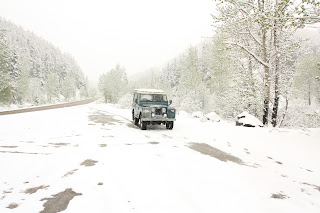The Land Rover, of course, took it all in a stride. I even used four wheel drive at one point!
Lewis and Clarke NF resides within a larger physiographic region refered to as the Little Belt Mountains. The Little Belt Mountains have a long history of mining with copper being discovered at Copperopolis (seriously I'm not making up the name!) and gold along Yogo Creek, both in 1866. Later, silver and lead were discovered, notably by James Neihart who founded the town of Neihart in 1881. Today the region is better known for it's recreational potential with hunting, fishing, skiing, snowmobiling and ATV'ing being very popular.
Before braving geology in the winter conditions I stopped at the Neihart Inconvenience Store (their name, not mine) and had a hot chocolate and a nice chat with Royal Westervelt, one of the proprieters. Neihart has a winter population of 36, all of which Royal knows the names of. If you're ever in the Little Belt Mountains stop by and have a coffee and chat. Very nice establishment.
I, of course, was here for the rocks. Unfortunately due to the atrocious weather I didn't get to see much of the rocks. They were buried under a good 6 inches (I've gone entirely Imperial now that I'm in the US so suck it up) of wet snow. This not only made observations difficult it also made work treacherous as on each step you had no idea what you'd get.
First an overview. The Little Belt Mountains are one of a number of Laramide structures found in the western US with similar structures at Rawlins, the Rattlesnake Hills, the Uinta Uplift and others. These structures largely post-date deformation in the Sevier or Rocky Mountain fold and thrust belts and record the last stage of active compression and mountain building in western North America. The Cambrian Flathead Sandstone sits unconformably on crystalline basement and Belt Supergroup rocks within the Little Belt Mountains and was the subject of my interest in the area.On to the rocks. Here is a general photograph of the Flathead.
In general it is a well bedded, upper medium to lower coarse grained, horizontal laminated, red to pink quartz arenite with no bioturbation. Here is a close up of a bed showing very nice ripple cross laminations which were rare.
I got my first sample of the Flathead and then moved on to an older unit, the Neihart Quartzite which is at the base of the Belt Supergroup, making it some billion years older than the Flathead. After collecting a sample there I drove the Cody, Wyoming my next sample location and campled at the KOA near the airport.
Today I will do some sampling above the Buffalo Bill Reservoir, again of the Flathead, at a location where the unconformity between proterozoic crystalline rocks and the Flathead is exposed. The weather has improved so I will likely spend most of the day there. I'll let you know how it went this evening.





Gorgeous Photos!
ReplyDeleteExcellent update Will!
ReplyDelete